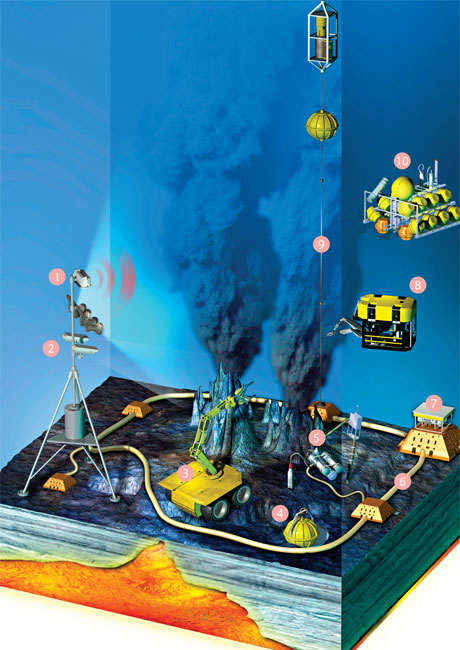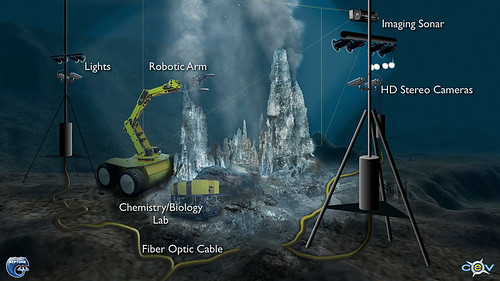sea.net
Wired reveals what "a permanent presence in the ocean" might look like, if that "presence" consisted entirely of manmade submersibles.
 [Image: From Wired].
[Image: From Wired].
This underwater robotic metropolis is otherwise known as the NEPTUNE Project. Specifically, Wired writes, the project "would string 10 semiautomated geobiological labs across the Juan de Fuca tectonic plate off Washington, 8,000 feet underwater. Each would have cameras, lights, robots, and sensors, all connected to the surface via optical cable to transmit data on everything from the biomass of microbes to the effects of ocean temperature on weather."
According to the project's own website, the "goal is for NEPTUNE to appear as a seamless extension of the global Internet, connecting users anywhere on shore to the sensors on the seafloor."
 [Image: A future seafloor exploratorium. Image provided courtesy of the NEPTUNE Project and produced by CEV].
[Image: A future seafloor exploratorium. Image provided courtesy of the NEPTUNE Project and produced by CEV].
As Space.com reported back in 2003, "the network itself will cover a region roughly 310 miles by 620 miles (500 kilometers by 1,000 kilometers) in size. More than two dozen experimental sites will form nodes along the sub-sea cable system. Nodes will be situated about 62 miles (100 kilometers) apart" – making the whole thing only slightly smaller than Great Britain.
On the other hand, the NEPTUNE Project should be thought of as a terrestrial analog for other, more far-flung, research stations: according to John Delaney, for instance, a similar set-up could be used to explore the oceans of Europa (about which more can be found here).
Given some oxygen tanks, it could also be the perfect location for a new public lecture series on architectural design...
(Not quite related: Open Ocean Aquaculture).
 [Image: From Wired].
[Image: From Wired].This underwater robotic metropolis is otherwise known as the NEPTUNE Project. Specifically, Wired writes, the project "would string 10 semiautomated geobiological labs across the Juan de Fuca tectonic plate off Washington, 8,000 feet underwater. Each would have cameras, lights, robots, and sensors, all connected to the surface via optical cable to transmit data on everything from the biomass of microbes to the effects of ocean temperature on weather."
According to the project's own website, the "goal is for NEPTUNE to appear as a seamless extension of the global Internet, connecting users anywhere on shore to the sensors on the seafloor."
 [Image: A future seafloor exploratorium. Image provided courtesy of the NEPTUNE Project and produced by CEV].
[Image: A future seafloor exploratorium. Image provided courtesy of the NEPTUNE Project and produced by CEV].As Space.com reported back in 2003, "the network itself will cover a region roughly 310 miles by 620 miles (500 kilometers by 1,000 kilometers) in size. More than two dozen experimental sites will form nodes along the sub-sea cable system. Nodes will be situated about 62 miles (100 kilometers) apart" – making the whole thing only slightly smaller than Great Britain.
On the other hand, the NEPTUNE Project should be thought of as a terrestrial analog for other, more far-flung, research stations: according to John Delaney, for instance, a similar set-up could be used to explore the oceans of Europa (about which more can be found here).
Given some oxygen tanks, it could also be the perfect location for a new public lecture series on architectural design...
(Not quite related: Open Ocean Aquaculture).





Comments are moderated.
If it's not spam, it will appear here shortly!
Post a Comment